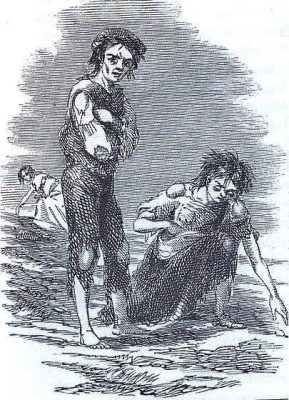The Heart-Wrenching Truth Behind the Great Irish Famine: Bad Government Policies and Unimaginable Suffering
Contrary to popular belief, the lack of food wasn’t the primary cause of most historical famines. In fact, the Great Irish Famine serves as a stark reminder that governments’ policies, at times deliberately, significantly contributed to people’s suffering. Let’s explore some of the most disturbing facts about this catastrophic period in history and marvel at how far we’ve come.
Ireland’s Tragic Import Policy: Starving People While Feeding Livestock
During the height of the Great Irish Famine, the Irish government imported maize and wheat into the country. Sadly, these imports were prioritized for livestock rather than providing relief to those dying of starvation. This image shows the Doolough Tragedy site, where hundreds died attempting to access aid.
tragedy-site.jpg” title=””>
The Outdoor Relief Program: A Glimmer of Hope Amidst Despair
In an attempt to alleviate the crisis, the authorities established the Outdoor Relief Program. This social welfare initiative aimed to assist the impoverished with food, money, and clothing. However, it was not an easy task for those in need to receive help. In 1849, hundreds of people had to trek approximately 19 kilometers (12 miles) to present themselves before the Poor Law Union Officials. Tragically, more than 20 people, including women and children, died of thirst and starvation near and around the shores of Doolough Lake.
Famine Follies: Creating Meaningless Projects to Maintain Privileges
To ensure the privileged maintained their jobs, the authorities in Ireland developed pointless construction projects known as “famine follies.” They hired people experiencing poverty to build useless infrastructure, including roads that led nowhere and undefined standing structures.
The Devastating Impact: A Population Decimated
Many people lost their lives in Ireland due to starvation and diseases during the Great Famine. However, it is challenging to determine the exact number of fatalities because the records kept by the Catholic Church were inconclusive. At the beginning of 1841, Ireland’s population was slightly over 8 million. Ten years later, in 1851, the number had reduced to about 6.5 million. If the population had not been affected by the famine, it should have risen to over 9 million people.
The Legacy of the Great Irish Famine: Glasgow Celtic FC
Today, a heavyweight soccer club in Scotland, Glasgow Celtic FC, was formed by Irish immigrants seeking refuge from the effects of the Great Irish Famine. In 2017, the club’s staff and players wore commemorative patches to honor the victims of the Great Hunger.
The Hardest Hit: Western and Southern Ireland
Although the entirety of Ireland and Europe were affected, the western and southern parts of Ireland suffered the most. Most of these areas spoke the Irish language, which is why the Great Irish Famine period is sometimes called “an Drochshaol” or “the bad life.”
The Timeline and Severity of the Great Irish Famine
The Great Irish Famine began in 1845 and continued until 1852, with the severity varying throughout these years. The worst phase was 1847 when relief food was scarce, rent prices soared, and unemployment flourished.
The World’s Response: Blight Spread Beyond Ireland
While Ireland was the worst-affected country, other contact countries were also affected. Reports suggest that the blight infection, which is believed to have been the primary cause of the catastrophe, killed over 100,000 people outside Ireland. Additionally, there was a culmination of social unrest resulting in revolutions across various parts of Europe in 1848 due to the famine.
The United Kingdom’s Role: Powerlessness or Mismanagement?
Between 1801 and when the famine started in 1845, about 114 commissions and 61 special committees were formed to investigate the state of Ireland. All concluded that the country was at risk of starvation, unemployment, and extremely low living standards – which came to fruition.
The Continuation of Hunger: Food Exports Amid Starvation
Despite the widespread hunger, massive amounts of foodstuffs were still being exported to England from Ireland. This angered and strained relationships between the two countries.
The Irish Potato: A Staple Food’s Devastating Loss
When potatoes were first introduced in Ireland, they were specifically for the high social class. By the 18th century, however, they had become a staple food. Laborers were even paid “potato wages.” This is why the potato blight caused insurmountable losses.
The Arrival of Blight: Europe’s Unwelcome Guest
Before the arrival of Phytophthora infestans, or “blight,” Ireland had only seen two potato diseases: curl and taint/dry rot. The disease is believed to have reached Europe from ships coming from New York City, Philadelphia, or Baltimore.
The Man in Charge: Charles Trevelyan’s Controversial Policies
Charles Trevelyan was the officer in charge of the administration of government relief during the Great Famine. When he took over, he immediately slashed aid programs and claimed that only those with money could access imported food. He believed the famine was a judgment from God.
The Mass Exodus: A Million Emigrants Leave Ireland
Between 1846 and 1851, about one million long-distance emigrants moved from Ireland. Most went to Scotland, North America, England, Canada, South Wales, and Australia. Liverpool received the most Irish emigrants.
A Potential Genocide: Was It a Crime Against Humanity?
Some view the Great Irish Famine as a potential genocide, but its lack of clear intent to destroy people prevents it from being classified as such. In 1996, Irish Americans demanded that the Great Hunger be included in New Jersey’s secondary schools curriculum, alongside other significant historical events.
Ireland’s Darkest Hour: The Great Irish Famine
The Great Irish Famine, also known as the Irish Potato Famine or an Drochshaol (the bad life), was a period of mass starvation and disease in Ireland. It lasted from 1845 to 1852, with the worst phase occurring in 1847. The famine led to the death and displacement of millions.
Irish Government’s Role: Mismanagement and Prioritization
Despite the suffering of the Irish population, the government imported maize and wheat into the country, prioritizing their use for livestock instead of helping to feed the starving people.
The Tragic Doolough Trek: A Journey to Receive Relief
Hundreds of people, including women and children, died of thirst and starvation during a journey to seek help from the Poor Law Union officials. They were asked to travel 19 kilometers (12 miles) to ascertain their need for assistance.
Famine Follies: Building Useless Infrastructure
The Irish authorities created unnecessary construction projects called “famine follies” to keep the privileged employed. These included roads that led nowhere and undefined standing structures.
The Human Cost: Deaths, Emigration, and Population Loss
More than one million people died during the Great Irish Famine, with many more emigrating to other countries. The population




